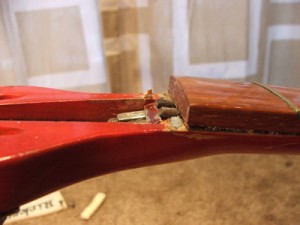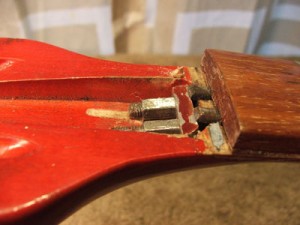 Here we have a Rickenbacker 12-string guitar with the typical Rick dual truss-rod system. The system generally works well, but has several design flaws, which have worked together to blow the neck of this guitar apart. The fingerboard has separated from the neck, and that the truss-rods are bent into the headstock. For those who are not well versed in the design and operation of these truss-rods, a quick explanation is in order: a Rick truss-rod is one long piece of flat steel, bent back over itself and inserted into the neck, with the bent end at the body and the twin ends at the headstock. Of the two ends at the headstock, the lower end is threaded and protrudes through a small aluminum block. The upper end is not threaded, and contacts the block. When the truss-rod nuts on the threaded ends, are tightened, they push the aluminum block against the non-threaded ends. This causes a back-bowing force, which counteracts the force of the strings, allowing for adjustment of neck relief.
Here we have a Rickenbacker 12-string guitar with the typical Rick dual truss-rod system. The system generally works well, but has several design flaws, which have worked together to blow the neck of this guitar apart. The fingerboard has separated from the neck, and that the truss-rods are bent into the headstock. For those who are not well versed in the design and operation of these truss-rods, a quick explanation is in order: a Rick truss-rod is one long piece of flat steel, bent back over itself and inserted into the neck, with the bent end at the body and the twin ends at the headstock. Of the two ends at the headstock, the lower end is threaded and protrudes through a small aluminum block. The upper end is not threaded, and contacts the block. When the truss-rod nuts on the threaded ends, are tightened, they push the aluminum block against the non-threaded ends. This causes a back-bowing force, which counteracts the force of the strings, allowing for adjustment of neck relief.
 This particular Rickenbacker’s faulty truss rod has created several problems: The first is that the aluminum block is not sufficiently long to support the threaded end without deflecting. This deflection causes the threaded ends to bend downward, making the truss rod ends dig into the headstock. This makes adjusting the rod difficult or impossible, as a wrench will no longer fit on the nuts. The second problem is that the non-threaded ends have climbed up the bent block, which acts like a ramp, and have exerted enough force to split the fingerboard from the neck. The third problem is that the threaded end of the rod is bent, and the threads are damaged.
This particular Rickenbacker’s faulty truss rod has created several problems: The first is that the aluminum block is not sufficiently long to support the threaded end without deflecting. This deflection causes the threaded ends to bend downward, making the truss rod ends dig into the headstock. This makes adjusting the rod difficult or impossible, as a wrench will no longer fit on the nuts. The second problem is that the non-threaded ends have climbed up the bent block, which acts like a ramp, and have exerted enough force to split the fingerboard from the neck. The third problem is that the threaded end of the rod is bent, and the threads are damaged.
What we had to do here is to repair the split fingerboard/neck joint, fix the bent and stripped truss-rods and make a longer, more supportive block so that this does not happen again.
 The first order of business was to pry the aluminum block off the bent truss-rods so that the rods could be extracted from the neck. After the block was off, we were able to grab the rods with a set of pliers and slide them out.
The first order of business was to pry the aluminum block off the bent truss-rods so that the rods could be extracted from the neck. After the block was off, we were able to grab the rods with a set of pliers and slide them out.
The truss rods had drastically bent from the pressure exerted by the block. We needed to cut back the ends and re-thread them, and then make a new block, which would be long enough to support the tension of the truss rods. We milled the new truss block out of solid aluminum, ensuring that the truss rods ends would never bend and tear apart the neck again. In order to provide room for the new, longer block, we had to cut the rods back to fit; using a Dremel cut-off wheel, we cut the ends back enough to allow us to re-thread them.
 We re-threaded the ends with a threading die to provide a proper fit for the truss rod nuts. There was enough thread to allow for the oversized block, and we ramped the non-threaded end slightly to help it push down, away from the fingerboard, minimizing the chance that it will split the neck again.
We re-threaded the ends with a threading die to provide a proper fit for the truss rod nuts. There was enough thread to allow for the oversized block, and we ramped the non-threaded end slightly to help it push down, away from the fingerboard, minimizing the chance that it will split the neck again.
Next we dealt with the split fingerboard/neck joint. After cleaning the old glue from the joint, we glued it back together using clamps and a caul to avoid damage to the neck. After the glue dried we re-inserted the truss rods, and installed the new aluminum block.
 The new block has three times the area of the old block, which will make it impossible for the ends of the rod to bend. This will also keep the nuts clear of the wood, allowing easy adjustability for many years.
The new block has three times the area of the old block, which will make it impossible for the ends of the rod to bend. This will also keep the nuts clear of the wood, allowing easy adjustability for many years.

This Post Has 8 Comments
Leave a Reply
You must be logged in to post a comment.



Kathleen,
Unfortunately we do not but if you can’t get ahold of someone at Rickenbacker, you can try reaching out to someone at http://www.pickofthericks.com. The re-fret needed is fairly common on older instruments, especially those with a lot of play. The luthier your customer talked to is correct; it is hard to level the frets as is because the fretboard is layered with finish, so the correct way to do it would be to re-fret & re-finish the fretboard. Hope this helps!
Does anyone have a contact person at Rickenbacker with whom i can discuss this problem? (below is an email i just got from an ebay customer to whom i just sold a like new 1998 Rick 370/12 which i purchased from Rickenbacker as original owner in January 1998 through Rainbow Guitars in Tucson). I kept the guitar preserved for 17 years, checked it periodically for tuning and intonation, played scales as notes and chords up and down the neck and never noticed anything odd. I didn’t get into playing the guitar a lot or for gigs simply because i didn’t like it as much as my acoustic guitars or as much as I thought i would like it. i kept it for collect-ability but lost money and lots of time on the sale, anyway. shipped it uber-carefully for $70 via Fed Ex. buyer wants to send it back and the costs of shipping, paypay, etc. make the loss even greater. and then i am seemingly stuck with a lemon guitar. need some advice on this situation. anyway, I was shocked to get the message below (i’ve been playing for fifty years and think i’d have noticed such an extreme problem with the neck– is it possible it tweaked in shipping?)
” I drove to Lawrence KS to have my luthier evaluate the guitar. That is Mass Street Music in Lawrence. He basically concurred with my views. There are two problems with the neck.
1) I have provided a picture of the truss rod adjustment section. When he saw this his words were “I don’t like the look of that”. As you see the metal backing plate is bent towards the treble side adjustment screw, and the threads on that screw are also bent in that same direction. He could not say what is causing this. It maybe be what I postulated in my previous email, that the anchor has been pulled into the cavity. But he said that rod may be twisted inside the neck. He checked to make sure there were no bulges at the back of the neck from pressure, and he found none. But he said the same thing I said, he “would not touch that adjustment screw”. It is just too risky to do so. So long as nothing gets worse than it is now it should be left entirely alone. This means that there will be a more relief on that side of the neck than the bass side, which is the opposite of what you want. And of course the risk remains even in leaving that adjustment alone, that the condition will deteriorate over time. i wish i could include a photo that he sent of the double truss rods. one looks a lot shorter and is tweaked, not parallel, with the other, ie closer to the front of the neck.
2) The second issue is that the frets are uneven. I noticed this myself, especially near the 4th fret but at other places as well. I had not played a 12 string and thought that was perhaps normal but I have learned from the luthier that it is not. It is not bad enough to actually kill the strings when the action is set at normal level, but you do hear some buzzing at places, and clean strikes at others. As you know a guitar should be very consistent in that regard. He said there is unevenness of the frets all over the neck, and a hump at one place. He said that the problem with Rickenbacker is that they don’t give you much to work with in the frets they use, the really only practical solution is to refret at a cost of $500-$600.
Bottom line is that while this guitar is nearly immaculate in appearance, it has neck issues. These do not make it unplayable, but it cannot be set up to play like a new Rickenbacker, the action has to be kept higher than what most people consider optimal, unless one is willing to accept some string buzzing. The truss rod situation could deteriorate over time, even if leaving the one faulty rod totally alone. So I have to request a return based on the fact that the guitar is not as described in your auction, i.e. “mint condition, as close to new as you get.” In my view the neck is the most critical aspect of a guitar, and it is in a condition far different than you described. I really was looking for a guitar without issues, and bid accordingly.”
John Hall from Rickenbacker says that the design on these old truss rods meant that you couldn’t just tighten it without physically bending the neck into place first and then adjusting the rod. otherwise, it would put all the pressure into popping the fretboard off, basically. It looks like that is what happened here.
He also claims that they’ve updated the design, thank god.
I have a 2008 Ric 360/12.and im having a problem with the plate that the truss tighten up against. Seems on the treble side of the neck the plate is digging in the cavity on that side of the neck therefore im am out of threads for adjustments. Is there and kind of hard epoxy glue or something of that nature that would fix this problem? Is it possible I could order a new plate from you and install it myself. I live in Ohio and been dealing with this problem for awhile. Please call me if you can. 330-383-0792 anytime. I need some advice. Im pulling my hair out. Thank you so much for your time. Gary (PS. Im not real good with computers, a phone call would work better for me)
On a repair like this, each case is different. We’d have to see it before we could provide a quote. Give a call or shoot us an email and we’ll be happy to take care of it for you.
I have a ricky 12 string with what looks like a similar problem. what does it cost for such a repair?
Brilliant solution! Kudos for your very creative thinking.
–Paul Wilczynski
Factory-licensed Rickenbacker luthier (also in SF).
That’s a nice and clever fix. Thanks for this article.
Best regards from France,
Pierre-Antoine